2023 Technology Catalogue Request
If you would like to receive a PASCO technology catalogue, please complete this form.
If you would like to receive a PASCO technology catalogue, please complete this form.
I’ve been a theorist and an experimentalist at different times throughout my career. When at university, theory won out over experimental but now, as a teacher of high school, experimental easily wins. There is nothing like watching students figure out problems, deduce scientific laws and test theories. The old problem was the equipment.
What can I do with ticker-tape?
How responsive are the thermometers?
How reliable is the data?
How big are the errors?
Is it going to work?
But now, with my PASCO equipment, things are changing. I’m more excited and so are my colleagues. The students are picking up on that excitement too. The labs we’ve done for decades are being updated. However, the real joy is in designing new ones.
Since September I’ve created three new labs besides updating the other eight I do. One for kinematics, one for gravity and one for momentum. The momentum one is great because we were never able to do a reliable lab before. Using the Smart Carts and Sparkvue the kids are designing safe barriers and analyzing crashes. My favourite part of that lab is having the students figure out if movies are lying to you when they show a person getting shot, flying backwards through a window, and landing a few metres on the other side of it. We can recreate the situation with the Smart Cart acting as the bullet and looking at the forces involved.
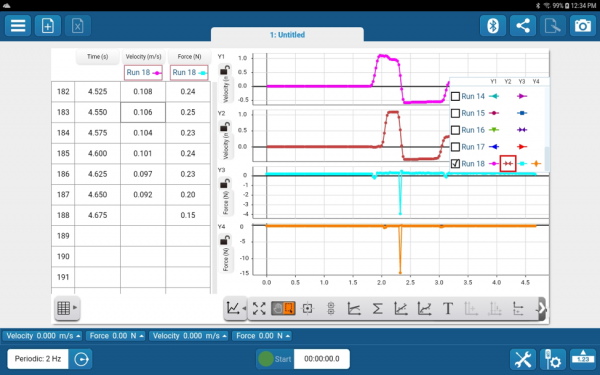
This screenshot represents a head-on collision between two smart carts. They were released at different times to offset v-t graphs.
As I was working on the design of the labs and testing them out, my colleagues and administration stopped by. They all wanted to see what I was up to. They could see my excitement. They were infected. Two team members went away and started designing their own labs. We are talking more, sharing more and the kids benefit from it.
We can ask deeper questions because the data is more reliable and relatable. We can do so much with the carts and are figuring out more each time. Labs in physics 12 were hard because of analysis to 2-D. We are creating labs for them. The goal is a least two new labs a month. The labs are also not so cookie-cutter. They don’t always have to be quantitative. They are exploring more and, hopefully, learning more.
All of this is possible because of the Smart Carts, Sparkvue and the joy of lab design.
The bell rings. Time to start class.
We are doing another lab today and today we will use the new technology! Cheers erupt from the class.
Yes, for today’s lab there will be no ticker tape. No counting dots! Welcome to SPARKvue! Everybody turn on your Sparks and open the software.
Mr. Grant? Mine says it needs a software update.
Go ahead and do it.
It won’t let me.
Oh, right. I go over and update.
Turn on your smart carts and connect them to SPARKvue.
Mine says it needs a firmware update. Mine too. And me!
Of course. Update all using my phone as it is faster than trying to get the Sparks to do it for some reason.
Are we ready? Allow the carts to roll down the ramp freely. Take data of time, position and velocity. Graph velocity vs time. What sort of shape are we looking for?
Straight lines!
Good. Go for it.
Mr. Grant. We aren’t getting any data.
Is it recording? The button changing from green to red and back again?
Yes.
Let me try…hmm…you are right. Let me see…Oh. You switched it to manual recording. Set it to periodic and try again.
Still nothing.
Let me see again. You have a frequency of 1 Hz. The cart is going too quickly to get data. Change your frequency. Is everybody else getting data?
Yes. Sure. My button isn’t responding.
Try a lighter touch.
Now it is.
Do around 50 runs. Figure out which run is your best one and why.
Does the whole graph need to be straight?
What do you think?
No…?
Right.
Once you have your best run copy down the table and then graph it. Your graph on paper should resemble the one on the Spark.
Do we need to copy down all the data?
How much do you have?
150 points.
<sigh> What do you think?
No…?
Why not?
That is more than need to show the pattern?
Good.
Time to put the equipment away. Please make sure it is turned off. What did we think about the new way of doing the lab?
Updates were frustrating.
Granted.
Took us a while to get used to it.
Fair enough.
Still way better than ticker tape though.
Good.
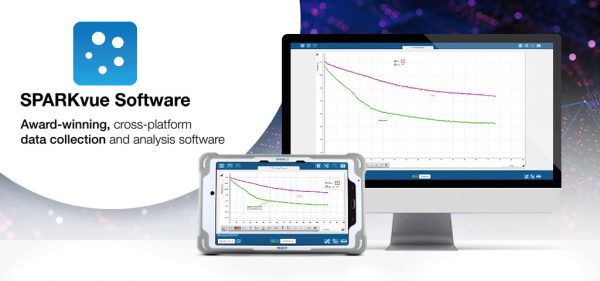
SPARKvue makes data collection, analysis, and sharing quick and easy on every platform. Compatible with all of PASCO’s wireless and PASPORT sensors, students can quickly set up their lab, or use a built-in Quick Start Lab and begin collecting data immediately. SPARKvue is for all sciences and grade levels. However, if you’re an advanced user looking for more capabilities such as video analysis, advanced statistics and calculations, and greater customization of data displays on a PC or Mac®, then check out our PASCO Capstone™ software.
Since SPARKvue was first released, it has been winning awards, and we never stop improving it. With the latest major release of SPARKvue 4, we’ve continued to add features without adding complexity. A new Welcome Screen makes it easy to get started and discover SPARKvue’s capabilities. Whether you want to add data manually, use sensors for real-time or remote logging, or open one of the hundreds of existing labs, this is your starting place.
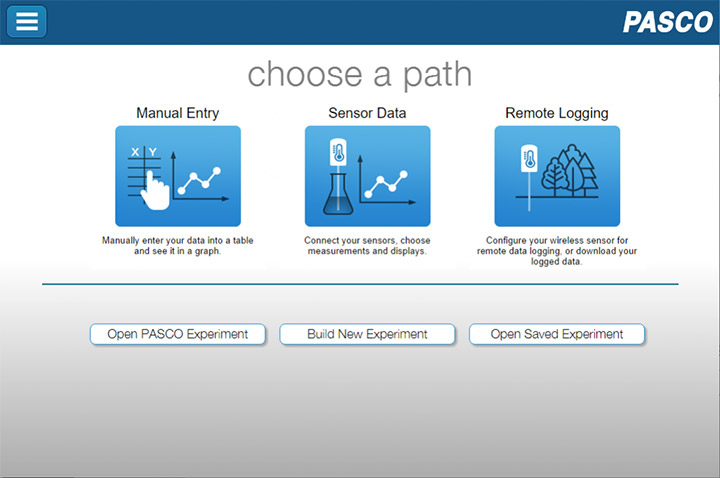
Using a USB or an interface, with SPARKvue you can just plug-and-play with nearly one-hundred sensors via Bluetooth®, which pairs wireless sensors through a simple in-app list (no system settings are required). PASCO understands that classrooms and labs can be hectic, so SPARKvue allows you to simply select a sensor from the sorted list (the closest sensors are first) and match a 6-digit laser-etched ID number to get connected. This method works even when there are dozens of Bluetooth sensors in the same lab.
Once you’ve selected a sensor, choose from a template or QuickStart Experiment, or you can build a page to meet your needs. SPARKvue is designed for inquiry, and students are not constrained to a few pre-selected layouts… the software can support expanding capabilities with ease.
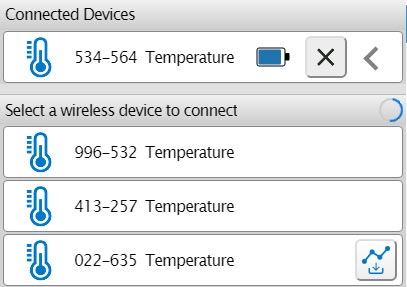
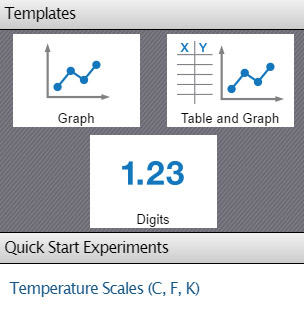
Collecting and visualizing data is easy with an array of displays, and the tools you need for analysis are right at your fingertips. Students can annotate data, apply curve fits, compare runs, create calculations, and much more! In-context tools make it simple to find what you’re looking for, which means that students spend their time learning the science, not the software.
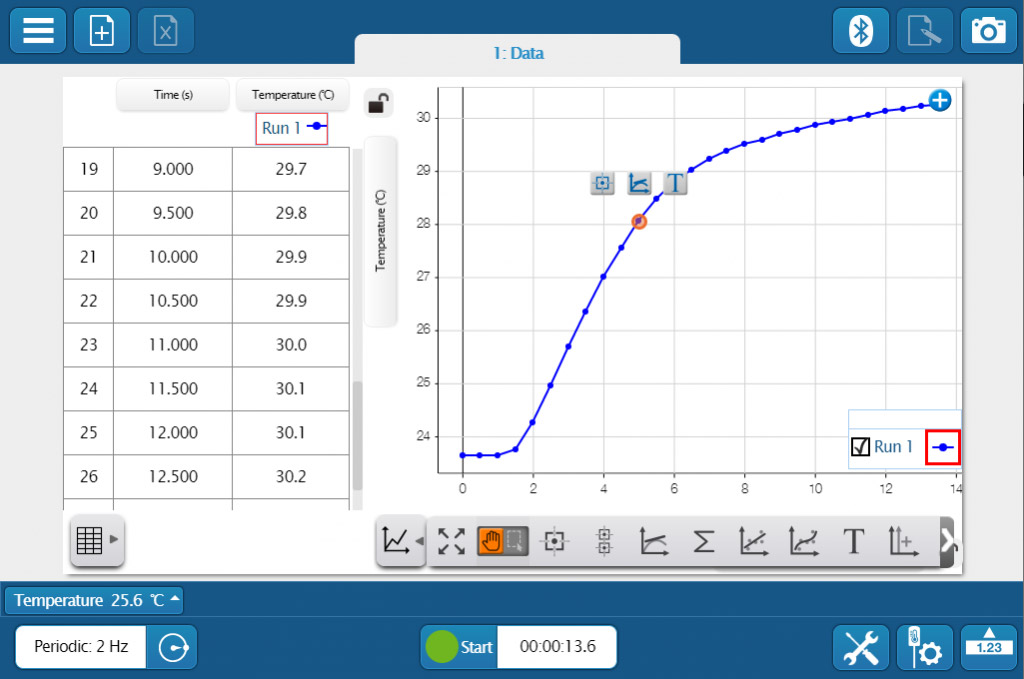 Whether you’re teaching K–8, high school, or college students, SPARKvue has the displays and tools you need to collect and analyze data. The basics you’d expect (such as digits, meter, graph, and table) are all included, but you will also find FFT, bar graphs, map display, embedded assessment questions, video playback, image capture, and analysis, as well as space for text and images. The labs you can build are only limited by your time and creativity.
Whether you’re teaching K–8, high school, or college students, SPARKvue has the displays and tools you need to collect and analyze data. The basics you’d expect (such as digits, meter, graph, and table) are all included, but you will also find FFT, bar graphs, map display, embedded assessment questions, video playback, image capture, and analysis, as well as space for text and images. The labs you can build are only limited by your time and creativity.
When it’s time for students to submit their work, SPARKvue supports a variety of formats, and its export tools make it easy for educators. Students can easily snapshot their work in SPARKvue and submit an image, export the data to a .csv file to work in a spreadsheet, or save it in our .spklab format when they can come back and do more work in the future. SPARKvue also supports many other apps for saving or sharing data, including Google Drive on Chromebooks™.
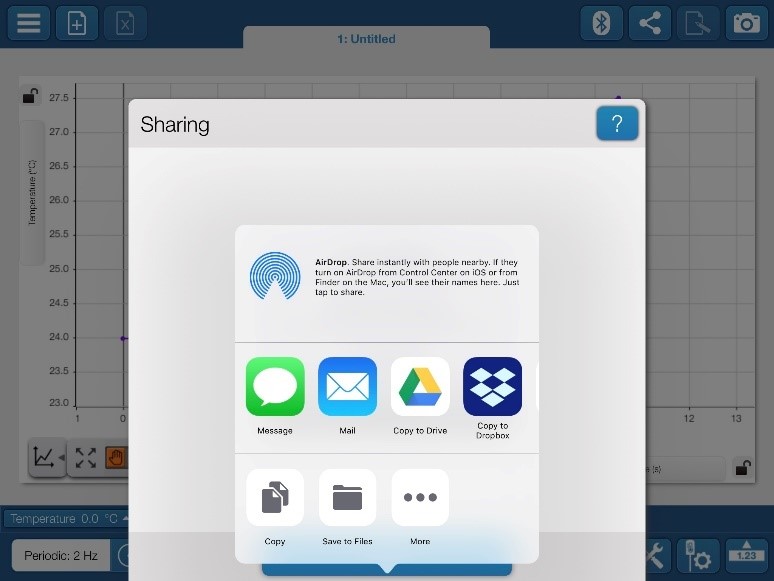 If students are collaborating on a lab activity across devices, they can set up a shared session and stream results in real-time. Then, when the session is over, each student will have a copy of the data to analyze independently. These sessions can be set up in seconds within a student group, or the entire class can share the data from a teacher demonstration.
If students are collaborating on a lab activity across devices, they can set up a shared session and stream results in real-time. Then, when the session is over, each student will have a copy of the data to analyze independently. These sessions can be set up in seconds within a student group, or the entire class can share the data from a teacher demonstration.
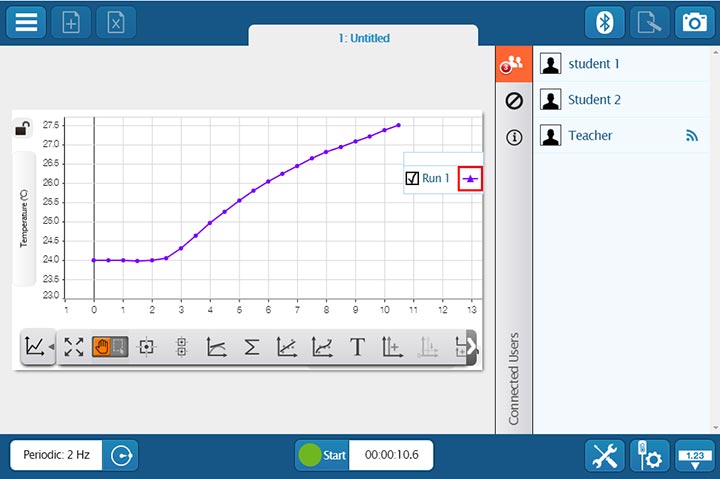
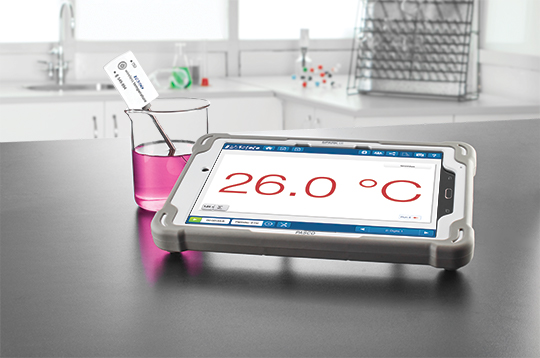
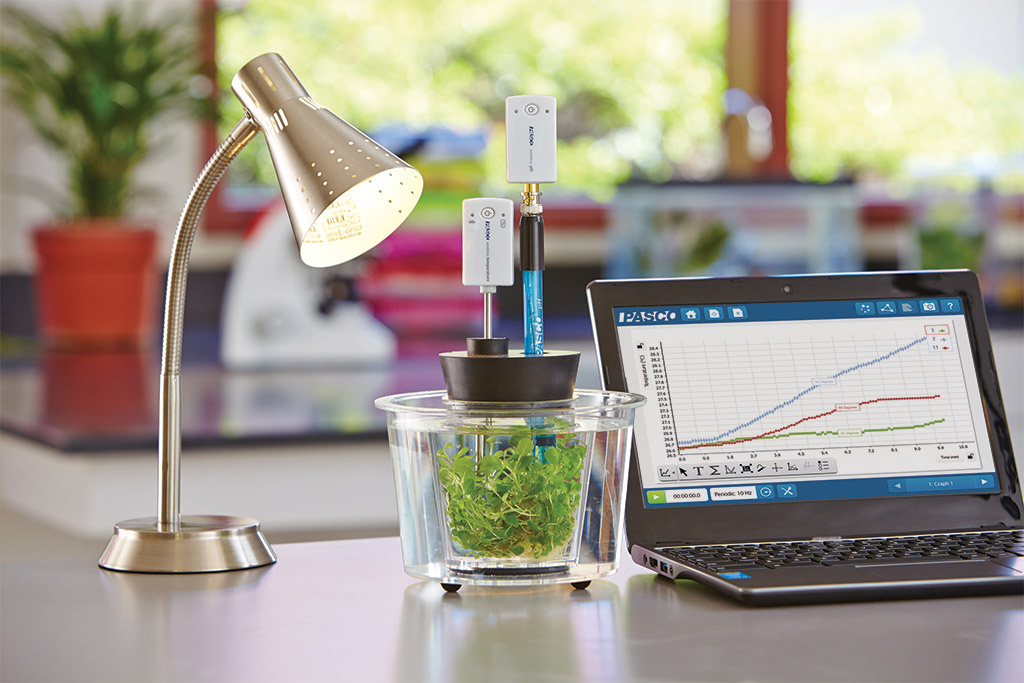
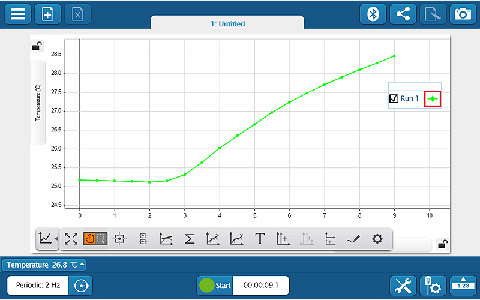
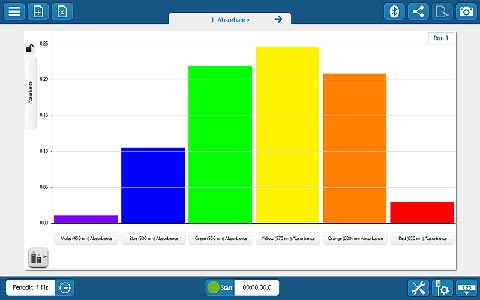
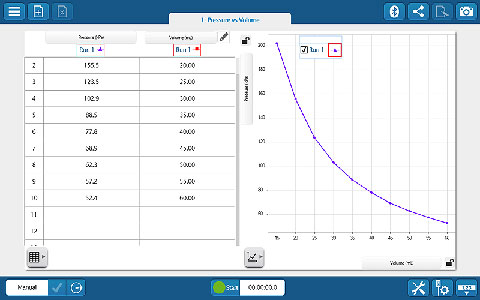
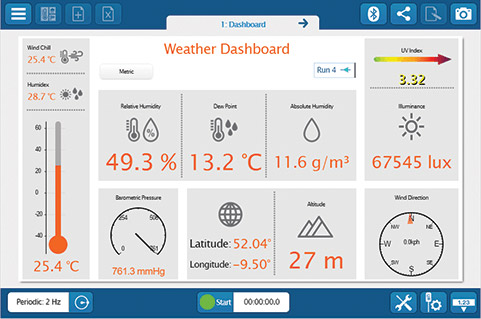
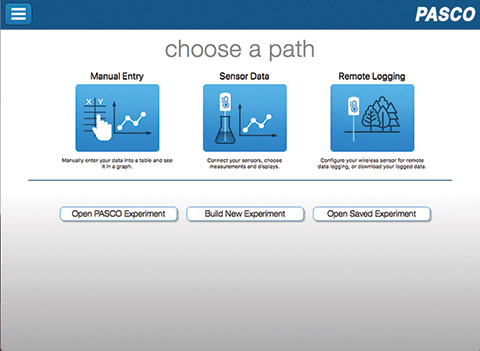
These SPARKvue apps provide the complete software install so that the user experience is the same regardless of platform. Updates for these apps are handled via direct notification and installation on your device, including SPARK LX/LXi users.
Let me paint you a picture. Not something physicists normally do but I’ll give it a shot.
I teach in a small town in BC. For most of my career it has been lower on the social-economic scale, a true blue-collar place but things are changing. More and more people are being pushed out of the big cities due to high house prices and ending up here where life is more laid back, more affordable, more idyllic?
Again, for most of my career the supplies I have had access to are the same supplies that came with the school when it was built…back in the 1950s. Trying to modernize my lab has been a challenge but just like the city, things are changing.
I’ve used PASCO products since my university days and have always found them to be intuitive and practical. When I had the chance, I purchased some of their GLX data loggers for demo purposes. I started to show the students the power of probeware and they yearned for more. Yes, I used yearn to describe students. I know, almost unheard of.
When I procured the funding to buy a class set of the GLXs after buying one a year for 5 years I was ecstatic. I called PASCO to order and was told that they were discontinued. I was bummed. What now? They told me about their new product, the Spark LX as a tablet data logger. I was intrigued. Many discussions happened, and I started to get on board. PASCO even took some of my suggestions about what I thought the logger should entail. After months of waiting they finally arrived; just in time for the start of a new school year.
I happily got to setting them all up and preparing their first interactions with the devices. I would use the Match-Graph software to give my physics students some hands-on real life to graph interactions. After a few hiccups of the airlinks needing firmware updates which my school computer wouldn’t allow I had the students head out into the school to test out the Spark and the software.
The looks we got from the other students and staff started as bewilderment. “What is his class up to now?” was heard more than once. My students didn’t even hear. They were too engaged to notice. The beginner graphs which were too hard mere seconds ago were now too easy. Harder graphs please. Harder and harder they went and the more competitive they got. “I’m addicted to this!” one student exclaimed. “I get it now.” Yelled another. They were hooked at first use.
I can’t wait to see how the next experiment goes. This is how technology should work in class. Relating physical experience to life experience to learning.
|
|
|
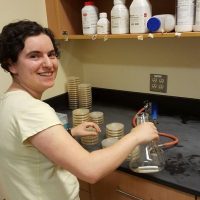
Who am I?
Hello World! My name is Maayan, and I am another co-op student at AYVA. I’m currently studying biochemistry at the University of Guelph, which is how I ended up on the AYVA Team. A bit more about me: I do not have any cute pets, but I do have two younger brothers. I’m interested in science, especially all the cool discoveries that can be made to improve the human condition. Outer space is rad. I can talk about Mars colonies for hours on end.
How did I get into science?
 As a wonderfully sweet little child, I frequently stole my brothers’ toys. I built Lego castles, controlled toy cars, and appropriated (stole) puzzles by the box. I liked building things, and I liked breaking things down to see how they worked. As I continued to grow into an adolescent, I enjoyed reading science fiction, enough to finish all the books my school library had.
As a wonderfully sweet little child, I frequently stole my brothers’ toys. I built Lego castles, controlled toy cars, and appropriated (stole) puzzles by the box. I liked building things, and I liked breaking things down to see how they worked. As I continued to grow into an adolescent, I enjoyed reading science fiction, enough to finish all the books my school library had.
Eventually, as I skipped on through life, I was assigned to do a school project on an important Canadian. I chose Julie Payette, an astronaut (and currently the Governor-General), and my interest was born. It was amazing to me that people had gone to the moon, and now different countries were collaborating on the International Space Station for scientific research. For the first time, I felt that people could come together for a cause to further humanity. The five-dollar bill is still my favorite: it has the Canadarm2 and the astronaut on it. To this day, I smile whenever I see one.
In high school I realized that astronauts couldn’t have gotten to space without a team of people down on earth who helped solve problems, and just because their jobs were less flashy (and got less camera time) it did not mean that they were any less important. Anyway, I liked biology (humans!) and enjoyed learning chemistry (and about the universe). I couldn’t decide which one I liked better, so biochemistry is the major I chose. No one seemed to be offering xenobiology or astrobiology courses at the time, but I hope someday they will.
What’s Next?
Back to the blog, I will be writing a few articles on teaching science through inquiry. This is important for future STEM-ists since teaching STEM is only a step before understanding STEM. After all, every inventor, scientist, engineer, mathematician, technologist, and astronaut started as a student.
Nice to meet you, and I hope to write again soon,
Maayan
Every 4 years, GLOBE hosts their annual conference outside the USA and this year we trekked to Killarney, Ireland to work with GLOBE coordinators, teachers, and students from all over the world. The conference began with an opening ceremony at the Killarney House which offered an incredibly scenic exhibit venue.

For the next several day’s attendees used PASCO equipment at two field sites to collect water quality data on the Owengarrif River. Sampling took place at the Upper Torc above the falls and the Lower Torc at the mouth of the river.

Having downloaded SPARKvue software to their phone or tablet the students and teachers connected to the Optical Dissolved Oxygen, Wireless pH, and Wireless Conductivity sensors to complete the Water Quality Protocol. We also deployed the new Wireless Weather Sensor which made the site set up a cinch, answering the two critical questions of “Where are we?” and “What are the current conditions?” right on the weather dashboard display.
While the map display is not required for this protocol being able to view the data in real-time on the map was helpful to give students a sense of the landscape and identify features that could impact the water quality. Happily, at every site, we sampled the Owengarrif was in good health, although it was running near-record low flow rates due to a 5wk drought and above-average temperatures.
Here’s a quick video of highlights during the conference – hopefully, we’ll see you there next year!
If you’re already a GLOBE teacher or PASCO user and want to see what protocols are supported with sensors, please visit our GLOBE page for an updated alignment. If you’d like to learn more about how to participate in the GLOBE program and get your students collecting data that will be used by scientists all over the world, please visit GLOBE.gov to get started.
The use of technology in STEM education is quite important because it supports inquiry learning. With the newest innovations from science equipment companies such as PASCO, there are even more ways to support inquiry using hands-on learning. In several independent studies, using inquiry-based learning has improved student confidence, interest, and performance in physical sciences.
The Impact of Inquiry Learning for Science Students
One study in Thailand by Tanahoung, Chitaree, Soankwan, Manjula and Johnston (2009) compared two first year introductory physics classes at the same university. One class was taught using a traditional method while the other class used Interactive Lecture Demonstrations. Interactive Lecture Demonstrations is a form of inquiry; students first predict the outcome of an experiment individually and then in groups. The demonstration is performed in real-time using micro-computer based laboratory tools (in this case a PASCO interface and a temperature sensor) and then students and/or instructor reflect on the concept based on their predictions and the actual results. For each thermodynamics concept, a pre-lecture and a post-lecture test was administered for comparison.
Tanahoung et al. found that in almost all of the concepts, there was a greater increased of percentage of correct answers between tests from the experimental group than the control group. These results show that teaching methods that use inquiry and technology are a novel and viable pedagogy for the 21st century.
Inquiry-based learning has been shown to improve grades in physical science courses for non-STEM students. In one particular study by Hemraj-Benny and Beckford (2014), a chemistry concepts such as light and matter was taught in relation to visual arts using a combination of traditional lectures and inquiry activities. The experimental group participated in group discussions, performed experiments using worksheets, created presentations, and had a summary lecture from the instructor. In contrast, the control group only had lecture-style lessons in which the instructor went over PowerPoint slides and certain scientific experiments in detail.
As a result, the class that received both inquiry and traditional lessons performed better in their final exam than the control group. More students in the experimental group reported better confidence and less fear in science than the control. Interestingly, Heraj and Beckford found that both the control and experimental group reported to have a greater appreciation of the scientific world after completing this course. Overall, this experiment shows that inquiry methods are especially beneficial for non-STEM students in understanding physical sciences. The critical skills taught in this course is an excellent example of how STEM skills can benefit everyone, including non-STEM majors.
The use of personal multifunctional chemical analysis systems has greatly improved student perception on chemistry experiments. As reported by Vanatta, Richard-Babb, and Solomon (2010), West Virgina University switched to the PASCO SPARK learning system and reported several benefits to using such systems like “less ‘waiting around time’” (Vannatta, Richard-Babb & Solomon, 2010, p. 772), the possibility of interdisciplinary and field experiments due to the versatility of using such equipment. Such as portability, ease of use and using microcomputer-based laboratories allows students to move at their own pace instead of waiting for others to move on. All of these benefits are factors to increased student retention and interest in chemistry majors.
Additionally, PASCO has upgraded from the portable SPARK learning system with built-in software to the downloadable SPARKvue software for computers and mobile devices. In another study, Priest, Pyke, and Williamson (2014) compare student perception using a handheld datalogger (the PASCO GLX system) versus SPARKvue on a laptop for the same chemistry experiment. Students were surveyed after using the GLX system for a vapour pressure experiment on their opinion on the lab. The next year, the school had phased out the GLX system and introduced SPARKvue using a laptop interface but kept the lab exactly the same. Researchers noticed more positive responses to the experiment when students used the laptop interface. Students perceived that the experiment was simpler and that the content was easier to understand when using SPARKvue because students are more familiar with a laptop and not a traditional datalogger, they experienced less frustration and spent less time learning how to use the necessary software to gather data.
A Guided Inquiry Lab – Results May Vary!
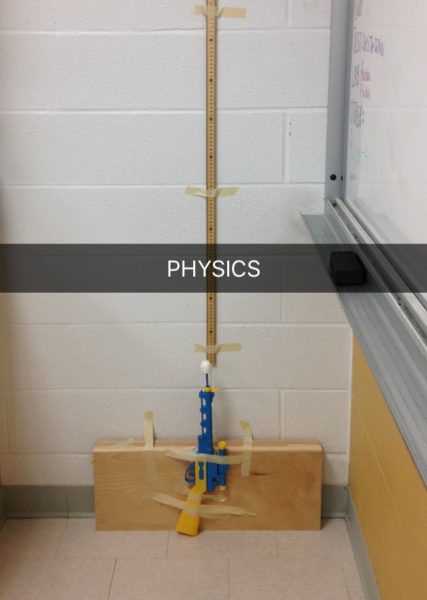
In my own studies, I benefited from inquiry labs and technology definitely made these labs easier. One of my favourite labs was a dart gun experiment where our groups were challenged to determine the theoretical spring constant of a dollar store dart gun by devising our own method. The goal of the experiment wasn’t to determine the actual spring constant since there weren’t actual springs in the dart gun, but to use what we knew from other units to create an experiment. We were given free reign over all the equipment in the classroom including the PASCO GLX and motion sensor and needed to keep a lab notebook in order to note any changes to the experimental method.
My partner and I opted for a low-tech option (pictured right) – we weighed the dart and determined the maximum height of its flight upwards so we could plug it into a kinematics equation to find the vertical velocity of the dart when it exited the chamber. This method was sort of tedious – I would launch the dart from the floor while my friend would video the dart on her phone while standing on a chair so we could replay and record when it reaches maximum height. This resulted in a few mishaps such as the dart perfectly falling into the adjacent broken glass box which we promptly moved. We also had to make several modifications to our experiment design to ensure that our data collection was consistent such as taping the dart gun so it exits perpendicular to the ground and adding weight to the dart gun so it doesn’t hit the ceiling before it reached its maximum height.
Another group decided on the easier (and safer) option of using the GLX and motion sensor to capture the horizontal acceleration of the dart when launched off of the table to model a Type 1 Projectile Motion problem. This method reduced a lot of uncertainty in their calculations since the sensors could accurately capture their data and they had the added benefit of not needing to precariously stand on a chair and guess-timate the maximum height. They also managed to finish a lot earlier and have more experimental runs than we did.
Although the sensors did end up making the experiment a lot easier for them, both of our groups were able to make connections between units and truly use the scientific method which made the experiment so much more interesting than our usual structured inquiry labs.
How You Can Support Inquiry Learning in Your Classroom
From these studies it is clear that inquiry-based learning and technology in STEM classrooms have short-term benefits such as increasing student interest and confidence. In addition, these two approaches to learning are complimentary to each other. The ease of use from technology decreases wait times and allows students to move at their own pace. Because students can move at their own pace, they are able to ask questions about the experiment itself. Students are able to benefit from making mistakes in this environment because the data logging software allows them to analyze what they did incorrect and why it is happening.
Through this approach, students are able to be curious in a controlled environment whilst developing essential scientific inquiry skills. There is also more time for meaningful discussion during class through using probeware since it reduces the amount of set up and lessons on how to use the equipment. Because of this, students are less likely to get frustrated or bored from experiments and helps students understand or reinforce their knowledge in the subject. This could improve the number of students pursuing a science education since students are less likely to leave if they are interested and confident in what they are learning.
PASCO and AYVA have a significant amount of resources that further demonstrates the positive impact that probeware technology has in science education such as White Papers on how PASCO supports scientific inquiry. AYVA also provides Curriculum Correlations for Canadian provinces which provides suggestions on how to incorporate PASCO technology into science classrooms across Canada.
References
Hemraj-Benny, T., & Beckford, I. (2014). Cooperative and Inquiry-Based Learning Utilizing Art-Related Topics: Teaching Chemistry to Community College Nonscience Majors. Journal of Chemical Education, 91, p. 1618-1622
Priest, S.J., Pyke, S.M., & Williamson, N.M. (2014). Student Perceptions of Chemistry Experiments with Different Technological Interfaces: A Comparative Study. Journal of Chemical Education, 91, p.1787-1795.
Tanahoung, C., Chitaree, R., Soankwan, C., Sharma, M.D., & Johnston, I.D., (2009). The effect of Interactive Lecture Demonstrations on students’ understanding of heat and temperature: a study from Thailand. Research in Science & Technological Education, 27(1), p. 61-74.
Vannatta, M.W., Richards-Babb, M., & Solomon, S.D. (2010). Personal Multifunctional Chemical Analysis Systems for Undergraduate Chemistry Laboratory Curricula. Joural of Chemical Education, 87(8), p. 770-772.
In my high school years I found that many of my classmates hesitated in pursuing science and engineering because of the ‘M’ in STEM. Math. When I was younger I didn’t really understand why everybody hated math so much – in my opinion it was more fun than having to draw (I’m a pretty bad artist). It also helps that I had a good teacher in grade 5 and 6 that gave me a healthy respect for math. Her math tests were infamous for being long and difficult but it helped me develop the necessary skills to succeed in high school.
I find that the biggest issue for students is that they have a negative view towards studying STEM and it’s a result of years of conditioning from teachers, parents, and peers telling them that the content is difficult to learn. Although it is not intentional, it has a significant effect on a student when they start thinking about what career they want to pursue.
EEK IT’S A PARABOLA! Oh wait it’s just a ghost.
 Although Math is its own discipline in STEM, all the other disciplines (science, technology, and engineering) inevitably involves math in some way. So many students have a fear of math and will avoid certain disciplines because it requires math. Quite often I would hear my classmates say that they won’t apply to a specific post-secondary program because it requires grade 12 calculus. This fear of math is so prevalent in our culture that it is almost like a badge of honour to say that you’re “not a math person”. My first year calculus professor has a good blog posts (here and here) that outlines why math anxiety can be detrimental and has other math resources and activities for teachers.
Although Math is its own discipline in STEM, all the other disciplines (science, technology, and engineering) inevitably involves math in some way. So many students have a fear of math and will avoid certain disciplines because it requires math. Quite often I would hear my classmates say that they won’t apply to a specific post-secondary program because it requires grade 12 calculus. This fear of math is so prevalent in our culture that it is almost like a badge of honour to say that you’re “not a math person”. My first year calculus professor has a good blog posts (here and here) that outlines why math anxiety can be detrimental and has other math resources and activities for teachers.
This applies for teachers as well – showing fear of math or any other subject can greatly affect how a student perceives that subject. In order to address this problem, STEM education for pre-service teachers must be improved. In one study by Gado, Ferguson, and van’t Hooft (2006), pre-service chemistry teachers were taught using probeware in their experiments which resulted in greater confidence in these subjects. By having more confidence in teaching the content, the teachers are less likely to project a fear of STEM but instead an interest and enthusiasm for the subject.
Using mathematical concepts in science is an effective way to make math seem less like a scary ghost. There are many ways to help your students reinforce their math skills within science lessons. With the use of probeware with built-in graphing software, math can be readily applied to real-life concepts thus helping students understand concepts both numerically and visually. It also explains math in a different way that some students may find more understandable.
Failure Is Not An Option (Or Is It?)
I think this negative attitude towards math and difficult subjects in general comes from the fear of failure. Acceptance into post-secondary education heavily relies on what grades students have and having a low score in a course could influence whether or not they get into a certain university program. I admit that I didn’t want to take physics or calculus because I knew that it would lower my acceptance average since they were quite difficult subjects.
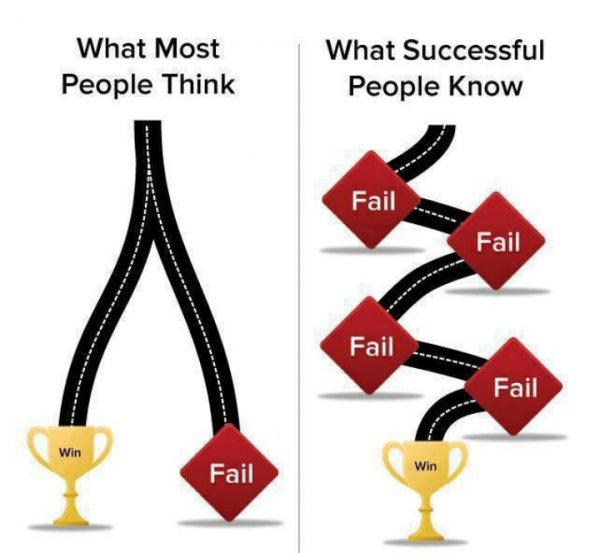
What I learned from these courses was far more valuable to me than a few percentage points and I’m not talking about derivatives and quantum physics. I learned how to fail in physics and calculus. I did have a fear of failure – the thought of even getting a 70 in a course was terrifying for me until grade 11. Learning new things was always easy for me and failure was never an option for the overachieving 16 year old me.
I failed a test in high school for the first time in my grade 11 physics class which was absolutely devastating. After some tears I picked myself up and tried to figure out where I went wrong. Obviously my study skills at the time weren’t effective so I had to develop different skills that would suit this type of course. I learned from my mistakes and tried harder. I ended up finishing that class with a 90 and an important life lesson. I learned that failing is okay as long as you learn from your failures. This is something that I didn’t really understand until I actually experienced it.
Although something is considered difficult or you think that you might not be good at it, it shouldn’t prevent you from at least trying. There is always something to learn from failure, even if it’s simply the confirmation that something is definitely not suited for you. This applies not only to STEM but in life.
In order for more students to pursue a STEM education, we need to start encouraging students to get out of their comfort zone and challenge themselves in areas that they are not as strong in even if they may fail. Remember, failure is an option!
References:
Gado, I., Ferguson, R., & van’t Hooft, M. (2006). Using handheld-computers and probeware in a Science Methods course: preservice teachers’ attitudes and self-efficacy. Journal of Technology and Teacher Education, 14(3), p. 501+.
I have taught grade 9 applied science, science and technology, grade 10 applied, regular and enriched science, grade 11 chemistry and physics for 33 years at Westwood Senior High School in Hudson Québec. I discovered the PASCO equipment in 2019 and it completely changed my life. I love to discover, produce experiments and share discoveries. I am looking forward to work with your team.
Having graduated with a major in Computer Science and minors in Physics and Mathematics, I began my teaching career at Killarney Collegiate Institute in Killarney, Manitoba in 2009. While teaching Physics there, I decided to invest in PASCO products and approached the Killarney Foundation with a proposal about funding the Physics lab with the SPARK Science Learning System and sensors. While there I also started a tremendously successful new course that gave students the ability to explore their interests in science and consisted of students completing one project a month, two of which were to be hands-on experiments, two of which were to be research based, and the final being up to the student.
In 2011 I moved back to Brandon, Manitoba and started working at the school I had graduated from, Crocus Plains Regional Secondary School. In 2018 I finally had the opportunity to once again teach Physics and have been working hard to build the program. Being in the vocational school for the region has led to many opportunities to collaborate with our Electronics, Design Drafting, Welding, and Photography departments on highly engaging inter-disciplinary projects. I believe very strongly in showing students what Physics can look like and build lots of demonstrations and experiments for my classes to use, including a Reuben’s tube, an electromagnetic ring launcher, and Schlieren optics setup, just to name a few that have become fan favourites among the students in our building. At the end of my first year teaching Physics at Crocus Plains I applied for CERN’s International High School Teacher Programme and became the first Canadian selected through direct entry in the 21 years of the program. This incredible opportunity gave me the opportunity to learn from scientists working on the Large Hadron Collider and from CERN’s educational outreach team at the S’Cool Lab. Following this, I returned to Canada and began working with the Perimeter Institute, becoming part of their Teacher Network.
These experiences and being part of professional development workshops with the AAPT and the Canadian Light Source (CLS) this summer has given me the opportunity to speak to many Physics educators around the world to gain new insights into how my classroom evolves. As I work to build our program, I am exploring new ideas that see students take an active role in their learning, more inter-disciplinary work with departments in our school, the development of a STEM For Girls program in our building, and organizing participation in challenges from the ESA, the Students on the Beamline program from CLS, and our local science fair.
Though I graduated with a BEd qualified to teach English and Social Studies, it just wasn’t meant to be. My first job was teaching technology courses at a local high school, a far cry from the English and Social Studies job I had envisioned myself in. I was lucky enough to stay in that position for over ten years, teaching various technology courses in grades 10-12, while also obtaining a Master of Education in Technology Integration and a Master of Education in Online Instructional Media.
You will notice what is absent from my bio is any background in science. In fact, I took the minimum amount of required science courses to graduate high school. Three years ago I switched roles and currently work as a Technology Integration Leader; supporting teachers with integrating technology into their pedagogy in connection with the provincial outcomes. All of our schools have PASCO sensors at some level (mostly grades 4-12) and I made it my professional goal to not only learn how to use them, but to find ways to make them more approachable for teachers with no formal science background (like me!). Having no background or training in science has allowed me to experience a renewed love of Science, making it easier for me to support teachers in learning how to use PASCO sensors in their classrooms. I wholeheartedly believe that if more teachers could see just how easy they are to use, the more they will use them in the classroom and I’ve made it my goal to do exactly that.
I enjoy coming up with out-of-the-box ways of using the sensors, including finding curriculum connections within subjects outside of the typical science realm. I have found that hands on activities with immediate feedback, which PASCO sensors provide, help students and teachers see the benefits of technology in the classroom and will help more students foster a love of science and STEAM learning.